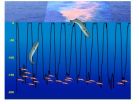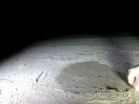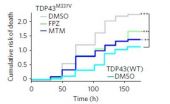(Press-News.org) "Consider the subtleness of the sea; how its most dreaded creatures glide under water, unapparent for the most part," wrote Herman Melville in Moby Dick. Today, we no longer dread whales, but their subtlety remains. "For a long time, whales have been considered too rare to make much of a difference in the oceans," notes University of Vermont conservation biologist Joe Roman. That was a mistake.
In a new paper, Roman and a team of biologists have tallied several decades of research on whales from around the world; it shows that whales, in fact, make a huge difference—they have a powerful and positive influence on the function of oceans, global carbon storage, and the health of commercial fisheries. "The decline in great whale numbers, estimated to be at least 66% and perhaps as high as 90%, has likely altered the structure and function of the oceans," Roman and his colleagues write in the July 3, 2014, online edition of Frontiers in Ecology and the Environment, " but recovery is possible and in many cases is already underway."
"The continued recovery of great whales may help to buffer marine ecosystems from destabilizing stresses," the team of scientists writes. This recovered role may be especially important as climate change threatens ocean ecosystems with rising temperatures and acidification. "As long-lived species, they enhance the predictability and stability of marine ecosystems," Roman said.
Baleen and sperm whales, known collectively as the "great whales," include the largest animals to have ever lived on Earth. With huge metabolic demands—and large populations before humans started hunting them—great whales are the ocean's ecosystem engineers: they eat many fish and invertebrates, are themselves prey to other predators like killer whales, and distribute nutrients through the water. Even their carcasses, dropping to the seafloor, provide habitat for many species that only exist on these "whale falls." Commercial whaling dramatically reduced the biomass and abundance of great whales.
"As humpbacks, gray whales, sperm whales and other cetaceans recover from centuries of overhunting, we are beginning to see that they also play an important role in the ocean," Roman said. "Among their many ecological roles, whales recycle nutrients and enhance primary productivity in areas where they feed." They do this by feeding at depth and releasing fecal plumes near the surface—which supports plankton growth—a remarkable process described as a "whale pump." Whales also move nutrients thousands of miles from productive feeding areas at high latitudes to calving areas at lower latitudes.
Sometimes, commercial fishermen have seen whales as competition. But this new paper summarizes a strong body of evidence that indicates the opposite can be true: whale recovery "could lead to higher rates of productivity in locations where whales aggregate to feed and give birth," supporting more robust fisheries.
As whales recover, there may be increased whale predation on aquaculture stocks and increased competition—real or perceived—with some commercial fisheries. But the new paper notes " a recent investigation of four coastal ecosystems has demonstrated the potential for large increases in whale abundance without major changes to existing food-web structures or substantial impacts on fishery production."
In death, whale carcasses store a remarkable amount of carbon in the deep sea and provide habitat and food for an amazing assortment of creatures that only live on these carcasses. "Dozens, possibly hundreds, of species depend on these whale falls in the deep sea," Roman notes.
"Our models show that the earliest human-caused extinctions in the sea may have been whale fall invertebrates, species that evolved and adapted to whale falls," Roman said, "These species would have disappeared before we had a chance to discover them."
Until recently, ocean scientists have lacked the ability to study and observe directly the functional roles of whales in marine ecosystems. Now with radio tagging and other technologies they can better understand these roles. "The focus of much marine ecological research has been on smaller organisms, such as algae and planktonic animals. These small organisms are essential to life in the sea, but they are not the whole story," Roman said.
New observations of whales will provide a more accurate understanding of historical population dynamics and "are likely to provide evidence of undervalued whale ecosystem services," note the ten scientists who co-authored this new paper, "this area of research will improve estimates of the benefits—some of which, no doubt, remain to be discovered—of an ocean repopulated by the great whales."
INFORMATION:
The new study was written by Joe Roman, University of Vermont; James A Estes and Daniel Costa, University of California, Santa Cruz; Lyne Morissette, M Expertise Marine, Sainte-Luce, Canada; Craig Smith, University of Hawaii, Manoa; James McCarthy, Harvard University; JB Nation, University of Hawaii, Honolulu; Stephen Nicol, University of Tasmania, Tasmania, Australia; Andrew Pershing, University of Maine, Orono, and Gulf of Maine Institute; and Victor Smetacek, Alfred Wegener Institute, Helmholtz Centre for Polar and Marine Research, Bremerhaven, Germany.
Whales as ecosystem engineers
2014-07-03
ELSE PRESS RELEASES FROM THIS DATE:
No two lark sparrows are alike (at least when it comes to migration habits)
2014-07-03
A new paper by Dr. Jeremy Ross from the University of Oklahoma describes the use of tiny devices strapped to birds' backs called geolocators, which capture the individual migration routes of lark sparrows in North America. By sensing the light levels, these backpacks can pinpoint the location of a bird anywhere in the world, even if retrieving the data-logger can sometimes pose a major problem.
This study, published in the online journal Animal Migration, mapped for the first time the routes traveled by three lark sparrows after they left their breeding grounds in Ohio. ...
Consider water use in climate change policies, advise Australian researchers
2014-07-03
There's more to trying to slow down climate change than just cutting greenhouse gas emissions. Technology, policies or plans that aim to do so should also take environmental factors such as water usage into account. A more integrated approach might make some options considerably more attractive than others, especially when implemented in arid countries such as Australia, advise Philip Wallis of Monash University in Australia and colleagues, in an article in Springer's journal Climatic Change.
The researchers considered the example of Australia to show how water usage ...
Jump to it! A frog's leaping style depends on the environment
2014-07-03
VIDEO:
Tree frogs reach great heights with their jumps, but do not cover much distance.
Click here for more information.
A frog's jump is not as simple as it seems....Australian scientists have discovered that different species adopt different jumping styles depending on their environment.
Lead researcher, Miss Marta Vidal-Garcia ( PhD candidate, Australian National University ), found that tree dwelling frogs reached great heights but didn't cover much distance with their ...
Study finds higher risk for celiac disease in some children
2014-07-03
AURORA, Colo. (July 3, 2014) – Physicians from the University of Colorado School of Medicine in collaboration with an international team of researchers have demonstrated that screening of genetically susceptible infants can lead to the diagnosis of celiac disease at a very early age.
The collaborative group studied 6,403 children with specific genetic markers from birth to identify the factors involved in the development of both celiac disease and type 1 diabetes. The children are from the United States, Finland, Germany and Sweden and are part of The Environmental Determinants ...
Biological signal processing: Body cells -- instrumentalists in a symphony orchestra
2014-07-03
Every organism has one aim: to survive. Its body cells all work in concert to keep it alive. They do so through finely tuned means of communication. Together with cooperation partners from Berlin and Cambridge, scientists at the Luxembourg Centre for Systems Biomedicine (LCSB) of the University of Luxembourg have now successfully revealed for the first time the laws by which cells translate signals from their surroundings into internal signals. Like an isolated note in a symphony orchestra, an isolated signal in the cell is of subordinate importance. "What is important ...
A CNIO team reduces the size of the human genome to 19,000 genes
2014-07-03
How nutrients are metabolised and how neurons communicate in the brain are just some of the messages coded by the 3 billion letters that make up the human genome. The detection and characterisation of the genes present in this mass of information is a complex task that has been a source of ongoing debate since the first systematic attempts by the Human Genome Project more than ten years ago.
A study led by Alfonso Valencia, Vice-Director of Basic Research at the Spanish National Cancer Research Centre (CNIO) and head of the Structural Computational Biology Group, and ...
Could boosting brain cells' appetites fight disease? New research shows promise
2014-07-03
ANN ARBOR, Mich. — Deep inside the brains of people with dementia and Lou Gehrig's disease, globs of abnormal protein gum up the inner workings of brain cells – dooming them to an early death.
But boosting those cells' natural ability to clean up those clogs might hold the key to better treatment for such conditions.
That's the key finding of new research from a University of Michigan Medical School physician scientist and his colleagues in California and the United Kingdom. They reported their latest findings this week in the journal Nature Chemical Biology.
Though ...
Ironing out details of the carbon cycle
2014-07-03
Iron is present in tiny concentrations in seawater. On the order of a few billionths of a gram in a liter.
"I did a calculation once on a ton of ocean water," says Seth John, an assistant professor in the department of marine science at the University of South Carolina. "The amount of iron in that ton of water would weigh about as much as a single eyelash."
Given that there is so little iron in seawater, one might conclude that its presence there is inconsequential.
Hardly. Iron is one of the essential elements of life. Found in enzymes like myoglobin and hemoglobin ...
Science Elements podcast highlights the science of fireworks
2014-07-03
The July feature of Science Elements, the American Chemical Society's (ACS') weekly podcast series, shines the spotlight on the science of fireworks, just in time for the July 4th holiday. The episode is available at http://www.acs.org/scienceelements.
Independence Day is a time for picnics, parades and, of course, fireworks. Those beautiful explosions in the sky would be nothing without chemistry. In today's episode, Science Elements talks to the man who literally wrote the book on fireworks.
"Everything you see in a fireworks display is chemistry in action," says ...
Decade of benefits for the Great Barrier Reef
2014-07-03
With this week marking the tenth anniversary of the rezoning of the Great Barrier Reef Marine Park, prominent marine scientists from around the world have gathered in Canberra to discuss its successes - both expected and unexpected.
"At the time, the rezoning of the Great Barrier Reef Marine Park was the largest marine conservation measure in the world," says Professor Garry Russ from the ARC Centre of Excellence for Coral Reef Studies (Coral CoE). "The Reef went from being five percent protected to about 30 percent. So now, a third of it is green, or no-take, zones."
Designed ...




